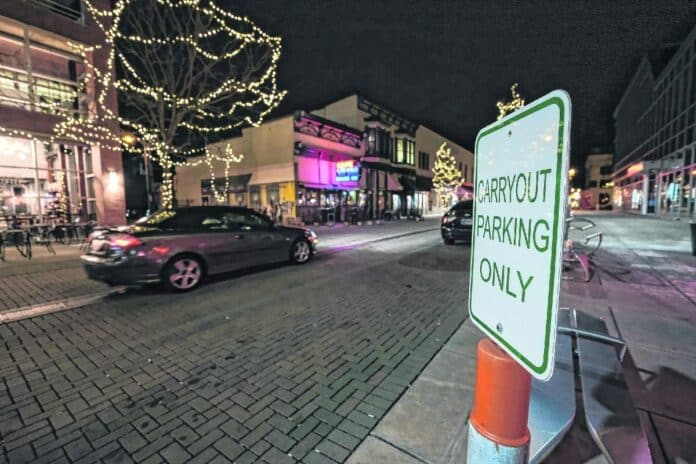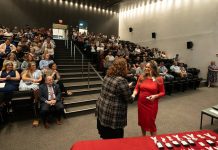
The Columbus Parking Commission is looking into having Nelson/Nygaard complete an update to its earlier study on the city’s downtown parking options.
The commission voted on June 3 to seek a new proposal from the group covering “procurement of parking kiosk technology” but felt that data updates were not needed.
Commission member and city engineer Dave Hayward said Thursday that he has received a revised proposal from Nelson/Nygaard and has also reached out to the Columbus Redevelopment Commission about possible funding for the revised study.
The parking commission members will take some time to read over the proposal, and Hayward said he’ll continue discussions with the redevelopment commission to gauge its interest.
The city had a different proposal for a while but didn’t necessarily agree with “everything in the scope that they were proposing,” he said.
He and other city officials, including both a redevelopment commission member and city councilman and commission member Tom Dell, had a conference call to discuss what should be included in the scope.
“Clearly, we can’t do a lot of data gathering right now, because with Cummins not having 1,000 employees downtown, everything’s changed,” Hayward said. “And so we can’t go back very easily and do an update. … So we’re working with eight-year-old data from 2013.”
He said earlier in the meeting that a “staff-level employee” told him that when Cummins, Inc. calls people back in September, probably about 75% will be on a hybrid schedule and only come into the office two to three days a week.
Dell said his understanding is that the company is finishing its pilot of having people back in the Cummins Office Building and will evaluate how it went as they plan for September.
Fellow commission member and downtown business owner Jeff Baker predicted that in a year or two, companies will return to a “more normal rhythm of business,” so it’s important to be prepared for that full-time return.
While it’s hard to use current data as a baseline, Hayward said that Nelson/Nygaard has offered to continue looking at aerial photos and pull some data from those. They also think it would be good to do at least some data gathering and revisit their previous recommendations to the city, he said.
In regards to parking enforcement, Hayward said that the city is “leaning toward” an incentive-based system, as opposed to the current “punitive” system. In the current model, drivers are ticketed for staying in spots past the posted time limits.
Under an incentive-based model, citizens can park where they want, but the rate they pay increases the longer they stay.
Those on the call also discussed changes in technology since the first study, Hayward said. For instance, are parking kiosks still the right solution? Or would it be better to used a “totally cellphone-based service” where members of the public could use an app to pay for parking?
Some parking commission members pointed out that not everyone has a smartphone or might have it on them when they’re downtown. Dell suggested that a hybrid model might be possible, with both the option of using an app to pay and some kiosks available as well. This would also mean that the city might not need to buy as many kiosks if they go in that direction, he added.
However, one downtown business owner suggested that the city should further examine the current system before moving to a new one. Jacob Martin with Columbus Wealth (located at the corner of Seventh and Washington) attended the meeting and discussed issues that his employees have had with parking.
For instance, if you park in a spot for only five minutes but are “clocked” within that time, you could come back after the three-hour limit has passed and be fined as if you had been there the whole time.
Baker said that paid parking could alleviate certain problems with the current system, as it would allow citizens to only pay for the length of time that they need. Other members also pointed out that there are currently spots downtown that can be leased or rented.
However, Martin said that if they could find a way to “update” the current system, it might provide helpful data to track downtown parking needs “before we invest full-blown in the metered parking.”
Paid parking would mean another expense for downtown business owners to work into their budgets, Martin said.
“As I grow staff, I’m going to have to think about that,” he said. “I’ve got three people in my office. So that means three people I’m going to have to pay for every day.”
While the company tries to use the free parking at Seventh and Franklin when they can, the lot is incredibly crowded, especially since employees from Centra Credit Union’s new downtown office now use spaces there.
As the meeting drew to a close, Hayward noted that the parking commission is still new and is working to “understand the problem” before they implement changes. He added that three-hour parking will remain for the time being, and “nothing’s going to happen overnight.”
“The next step will probably be an ordinance,” he said. “…We’ll review it and recommend that to city council. It’ll be up to them. And then once we have an ordinance that’s ready to roll out, we’ll look at purchasing equipment if it requires that. But all of this is going to take months, maybe a year or more. I don’t know.”




